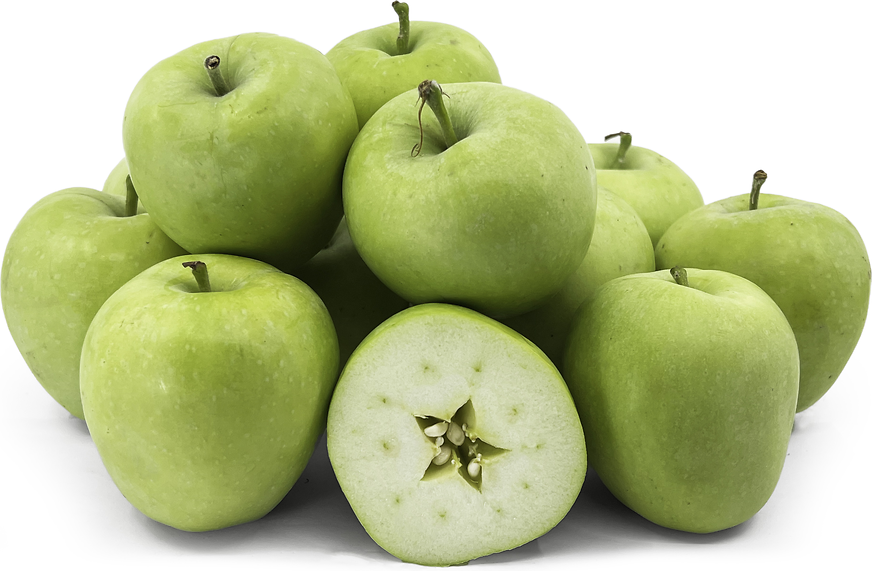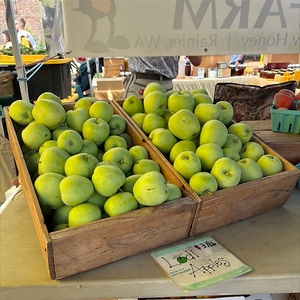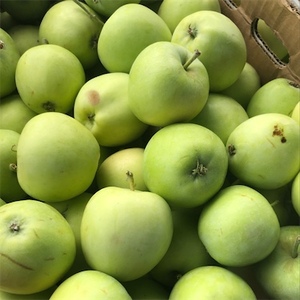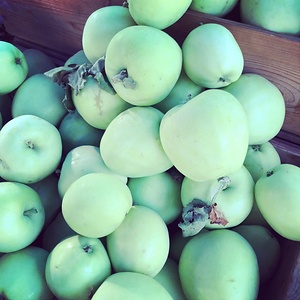


Lodi Apples
Estimated Inventory, lb : 0
Description/Taste
Lodi apples are a small to medium-sized varietal that varies in size and ranges from round, ovate, to conical in shape with flat shoulders tapering to a narrow base. The apple’s stems are fibrous, thick, and woody, and the skin is semi-thin, taut, smooth, and firm. The surface ripens from green to pale yellow-green and is sometimes flushed with light pink to brown-yellow blush patches. The skin also exhibits white to pale green lenticels scattered across the surface. Some lenticels may have tiny dots of brown russet, creating an indented spot on the fruit’s surface. Lodi apples bruise easily, and some ribbing surrounds the eye at the bottom of the fruit. Underneath the skin, the ivory to white flesh is flecked with green tones and is aqueous, medium-grained, and crisp with a succulent consistency. The flesh also encases a moderately sized central core filled with oval to teardrop-shaped seeds. Lodi apples lack an aroma and are initially tart, followed by a subtly sweet aftertaste. Raw Lodi apples are sharper, tarter, and more acidic than Granny Smith apples and have faint undertones of ginger, vanilla, and grapefruit.
Seasons/Availability
Lodi apples are available in early summer through mid-summer, with a peak season from June to July.
Current Facts
Lodi apples, botanically classified as Malus domestica, are an American variety belonging to the Rosaceae family. The early-season apples are one of the first cultivars to appear in American markets, often arriving during the summer. Lodi apples were developed through the New York State Agricultural Experiment Station in the early 20th century and were released as an improved summer variety. The apples grow on dwarf, semi-dwarf, and standard-sized trees, reaching 3 to 6 meters in height, and growers favor the variety for its cold hardiness, powdery mildew resistance, and productive, vigorous nature. Lodi apples are also known as Lodi Transparent, Improved Yellow Transparent, Early Golden, June Apple, and Golden Lodi apples and are only available for a limited season, spanning a few weeks each summer. The variety is not commercially cultivated due to its short shelf life, and the flesh frequently cracks and becomes mealy in storage. Despite their lack of commercial production, Lodi apples have become a valued home garden variety in the southern United States and are popularly used in cooked applications, specifically sauces and baked goods.
Nutritional Value
Lodi apples are a source of calcium to build strong bones and teeth, fiber to regulate the digestive tract, vitamin C to strengthen the immune system, and potassium to balance fluid levels within the body. The variety also provides vitamin A to maintain healthy organ functioning, vitamin E to protect the cells against free radical damage, iron to develop the protein hemoglobin to transport oxygen through the bloodstream, antioxidant to reduce inflammation, and other nutrients, including phosphorus, zinc, copper, boron, and magnesium.
Applications
Lodi apples have a tart, subtly sweet taste suited for fresh and cooked preparations. The variety can be eaten out of hand, but most consumers find it too tart to enjoy on its own. Lodi apples can be layered on sandwiches as a tangy ingredient, served on cheese platters, or shredded into slaws with other sweet ingredients to balance the flavor. In addition to fresh preparations, Lodi apples are popularly cooked into applesauce. The variety’s tart nature creates a well-rounded sauce, and the applesauce can be eaten with toast, mixed into cookie batter, dolloped over oatmeal, or used as a dipping sauce. Applesauce can also be served with pork chops as a savory-sweet accompaniment, and when simmered into a sauce, spices such as ginger, nutmeg, cinnamon, or cloves can be added for additional zest. Try baking Lodi apples into pies, muffins, or bread. The apples can also be used to make juice or cider, cooked into apple butter, or dried into fruit leather. Lodi apples pair well with roasted nuts such as cashews, almonds, and walnuts, yogurt, cheeses such as cheddar, manchego, cottage, and ricotta, meats such as beef, pork, sausage, and poultry, and fruits such as bananas, grapes, and plums. Whole, unwashed Lodi apples have a short shelf life, easily cracked, and will only keep for 1 to 2 weeks when stored in a cool, dry, and dark place. Lodi apples can also be sliced and frozen for extended use.
Ethnic/Cultural Info
Lodi apples were named after Lodi, New York, a town in Seneca County. It is tradition for apple varieties created at the New York State Agricultural Experiment Station to be named after towns in New York. The town of Lodi in New York was also named after the city of Lodi in Northern Italy in the Lombardy region. Richard Wellington, the Lodi apple’s breeder, worked at the experiment station for 47 years, and for 25 of those years, he served as department head. The New York State Agricultural Experiment Station released over 66 new apple varieties since its establishment, and Wellington took part in creating 21 of the 66 cultivars, including Lodi, Macoun, Kendall, and Early McIntosh apples. The New York State Agricultural Experiment Station, abbreviated to NYSAES, in Geneva, is the sixth oldest research station in the United States. The station was established as an independent state institution under the Department of Agriculture in 1880 and was created to conduct research and breeding to advance agriculture in New York State. It was also built to develop a network between growers. During this time, agriculture accounted for over half of the labor force in New York and was one of the largest industries in the state. In 1923, the station became a part of Cornell University's College of Agriculture and Life Sciences.
Geography/History
Lodi apples are native to the United States and were created at the New York State Agricultural Experiment Station in Geneva, New York. The variety was bred in 1911 by scientist Richard Wellington from a cross between Yellow Transparent apples and Montgomery Sweet apples, also known as Autumn Bough. Wellington took the pips of Yellow Transparent and used the pollen from Montgomery Sweet to generate a new cultivar that has improved traits over its Yellow Transparent parent variety. Lodi apples exhibited a larger size, more reliable growth characteristics, and a hardier nature than Yellow Transparent. The new variety was released to commercial markets in 1924, and while it never became a widespread commercial variety due to its short shelf life, Lodi apples were selected by home gardeners and specialty growers as an early-season apple. Today, Lodi apples are primarily grown in the Southern United States, especially in Kentucky and Virginia. The variety is also cultivated on the East Coast, in Washington, Oregon, Illinois, and Ohio. Outside the United States, Lodi apples are sold as home garden trees in Australia and planted in a few orchards in the United Kingdom. When in season, Lodi apples are found through farmer’s markets and directly through growers.
Recipe Ideas
Recipes that include Lodi Apples. One
| Thyme & Love |
|
Roasted Tomatillo Apple Salsa |
| Writes for food |
|
Grandma's Lodi Applesauce |











